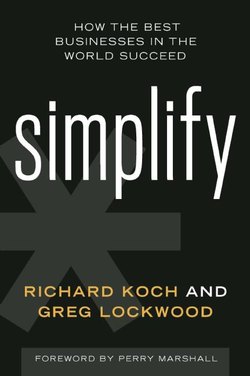Читать книгу Simplify - Richard Koch - Страница 7
На сайте Литреса книга снята с продажи.
ОглавлениеPreface
RICHARD KOCH
For the past forty years I have searched for simple, elemental, elegant, and parsimonious principles that will help individuals create great new businesses, and thus enrich the world and the people involved.
Principles are wonderful things, because if they are really powerful they can save us enormous effort and stop us going down dead ends. In science and business there are just a few such principles; but whereas most scientists are aware of the beautiful principles in their field, few business people are guided by principles in their daily work, preferring to rely on methods — the next level down. Yet, as the nineteenth-century philosopher Ralph Waldo Emerson said, “As to methods there may be a million and then some, but principles are few. The man who grasps principles can successfully select his own methods. The man who tries methods, ignoring principles, is sure to have trouble.”
To qualify, a principle must be so overwhelmingly powerful that ordinary mortals — such as you or me — can reliably create extraordinary results, not through personal brilliance, but just by following the principle carefully and with a modicum of common sense.
The principles can tell you which businesses you can create or work within, with a reasonable expectation that if you follow the principles, the business will stand a great chance of success.
Through trial and error, I have had some success in identifying some really stunning principles. If you had asked me four years ago which single principle works best in business, I would have said the Star Principle. As you may know, this is my interpretation of the famous “Boston Box,” invented by the Boston Consulting Group. Also known as the Growth–Share Matrix, the Boston Box says that every business falls into one of four categories:
Star — the largest business in a high-growth market.
Question mark — a business in a high-growth market but not the largest in it.
Cash cow — the largest business in a low-growth market.
Dog — a business in a low-growth market that is not the largest in it.
The Star Principle says:
The best businesses are “stars”: that is, they hold the number-one position in a market or niche that is growing fast (by at least 10 percent a year over several years).
Stars are incredibly valuable because they can grow exponentially, while also being very profitable and cash positive.
Stars comprise only about one or two out of every hundred businesses, yet they account for more than 100 percent of cash generated over the lifetime of the product (because some non-star businesses absorb more cash than they generate). Hence stars are the businesses where entrepreneurs, venture capitalists, and other investors make all their money.
It is possible to create a new star business by overtaking the early leader in your market, by inventing a whole new business category from scratch, or by re-segmenting into a new business category that is a subset of the original market.1
By applying the Star Principle to my investments I have built up my personal wealth.2 Over the past twenty-three years I have invested in 16 startups or young companies, of which eight have returned at least five times my original capital. This has created returns of about 20 percent a year compounded — far above the average attained by professional venture capitalists.
How have I managed to do this? By following the Star Principle. I now invest only in businesses that are stars or have the potential to become stars in their particular markets.
There is, however, a problem. The Star Principle tells you whether an existing business is already a star. But it does not tell you how to create a star business, nor how to overtake the market leader in a high-growth market and thus become a star.
So is there another principle that can tell you how to do that, reliably and with a high chance of success?
I have spent the last four years trying to find out.
Working with the venture capitalist Greg Lockwood — my co-author on Superconnect — and supported by top-quality research from OC&C Strategy Consultants, I believe we have an answer. Dare I say, the answer?
And that answer is to simplify a business and a market.
If you wish to learn why that’s so important, and how to do it, read on.
